by Nic Haygarth | 18/04/20 | Tasmanian high country history
When 52-year-old Maria Francis died of heart disease at Middlesex Station in 1883, Jack Francis lost not only his partner and mother to his child but his scribe.[1] For years his more literate half had been penning his letters. Delivering her corpse to Chudleigh for inquest and burial was probably a task beyond any grieving husband, and the job fell to Constable Billy Roden, who endured the gruesome homeward journey with the body tied to a pack horse.[2]

Base map courtesy of DPIPWE.
By then Jack seems to have been considering retirement. He had bought two bush blocks totalling 80 acres west of Mole Creek, and through the early 1890s appears to have alternated between one of these properties and Middlesex, probably developing a farm in collaboration with son George Francis on the 49-acre block in limestone country at Circular Ponds.[3]
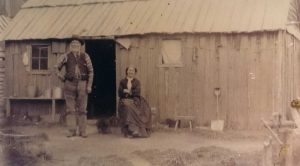
Jack Francis and second partner Mary Ann Francis (Sarah Wilcox), probably at their home at Circular Ponds (Mayberry) in the 1890s. Photo courtesy of Shirley Powley.
Here Jack took up with the twice-married Mary Ann (real name Sarah) Wilcox (1841–1915), who had eight adult children of her own.[4] Shockingly, as the passing photographer Frank Styant Browne discovered in 1899, Mary Ann’s riding style emulated that of her predecessor Maria Francis (see ‘Jack the Shepherd or Barometer Boy: Middlesex Plains stockman Jack Francis’). However, Mary Ann was decidedly cagey about her masculine riding gait, dismounting to deny Styant Browne the opportunity to commit it to posterity with one of his ‘vicious little hand cameras’.[5]
Perhaps Mary Ann didn’t fancy the high country lifestyle, because when Richard Field offered Jack the overseer’s job at Gads Hill in about 1901 he took the gig alone.[6] This encore performance from the highland stockman continued until he grew feeble within a few years of his death in 1912.[7]
Mary Ann seems to have been missing when the old man died. Son George Francis and Mary Ann’s married daughter Christina Holmes thanked the sympathisers—and Christina, not George or Mary Ann, received the Circular Ponds property in Jack’s will.[8] Perhaps Jack had already given George the proceeds of the other, 31-acre block at Mole Creek.[9]

Field stockmen Dick Brown (left) and George Francis (right) renovating the hut at the Lea River (Black Bluff) Gold Mine for WM Black in 1905. Ronald Smith photo courtesy of the late Charles Smith.
By the time Mary Ann Wilcox died in Launceston three years later, George Francis had long abandoned the farming life for the high country. He was at Middlesex in 1905 when he renovated a hut and took part in the search for missing hunter Bert Hanson at Cradle Mountain.[10] Working out of Middlesex station, he combined stock-riding for JT Field with hunting and prospecting.
Like fellow hunters Paddy Hartnett and Frank Brown, Francis lost a small fortune when the declaration of World War One in July 1914 closed access to the European fur market, rendering his winter’s work officially worthless. At the time he had 4 cwt of ‘kangaroo and wallaby’ (Bennett’s wallaby and pademelon) and 60 ‘opossum’ (brush possum?). By the prices obtaining just before the closure they would have been worth hundreds of pounds.[11] Sheffield Police confiscated the season’s hauls from hunters, who could not legally possess unsold skins out of season.
The full list of skins confiscated by Sheffield Police on 1 August 1914 gives a snapshot of the hunting industry in the Kentish back country. Some famous names are missing from the list. Experienced high country snarer William Aylett junior was now Waratah-based and may have been snaring elsewhere.[12] Bert Nichols was splitting palings at Middlesex by 1914 but may not have yet started snaring there.[13] Paddy Hartnett concentrated his efforts in the Upper Mersey, probably never snaring the Middlesex/Cradle region. His double failure at the start of the war—losing his income from nearly a ton of skins, and being rejected for military service—drove him to drink.[14]
‘Return of skins on hand on the 1st day of August [1914] and in my possession’, Sheffield Police Station.
| Name |
Location |
Kangaroo/wallaby |
Wallaby |
Possum |
| George Francis |
Msex Station |
448 lbs |
|
60 skins |
| Frank Brown |
Msex Station |
562 skins+ 560 lbs |
|
108 skins |
| DW Thomas |
Lorinna |
960 lbs |
|
310 skins |
| William McCoy |
Claude Road |
600 lbs |
|
66 skins |
| Charles McCoy |
Claude Road |
40 lbs |
|
|
| Geo [sic] Weindorfer |
Cradle Valley |
31 skins |
|
4 skins |
| Percy Lucas |
Wilmot |
408 skins |
|
56 skins |
| G Coles |
Storekeeper, Wilmot |
|
5 skins |
|
| Jack Linnane |
Wilmot |
|
15 skins |
|
| WM Black |
Black Bluff |
50 skins |
|
3 skins |
| James Perry |
Lower Wilmot |
|
2 skins |
13 skins |
Most of those deprived of skins were bush farmers or farm labourers who hunted as a secondary (primary?) income, while George Coles was probably a middleman between hunter and skin buyer:
Frank Brown (1862–1923). Son of ex-convict Field stockman John Brown, he was one of four brothers who followed in their father’s footsteps (the others were Humphrey Brown c1855–1925, John Thomas [Jacky] Brown, 1857–c1910 and Richard [Dick] Brown). He appears to have been resident stockman at Field brothers’ Gads Hill Station in 1892.[15] Frank and Louisa Brown were resident at JT Field’s Middlesex Station c1905–17. He died when based at Richard Field’s Gads Hill run in 1923, aged 59, while inspecting or setting snares on Bald Hill.[16]
David William Thomas (c1886–1932) of Railton bought an 88-acre farm on the main road at Lorinna from Harry Forward in 1912.[17] His 1914 skins tally suggests that farming was not his main source of income—so the loss must have been devastating. Other Lorinna hunters like Harold Tuson were working in the Wallace River Gorge between the Du Cane Range and the Ossa range of the mountains.
William Ernest (Cloggy) McCoy (1879–1968), brother of Charles Arthur McCoy below, was born to VDL-born William McCoy and Berkshire-born immigrant Mary Smith at Sheffield.[18] He was the grandson of ex-convict John McCoy and the uncle of the well-known snarer Tommy McCoy (1899–1952).[19]
Charles Arthur (Tibbly) McCoy (1870–1962) was born to VDL-born William McCoy and Berkshire-born immigrant Mary Smith at Barrington.[20] He was the grandson of ex-convict John McCoy. Charles McCoy caught a tiger at Middlesex, depositing its skins at the Sheffield Police Office on 30 December 1901.[21] He was the uncle of the later well-known snarer Tommy McCoy.
Gustav Weindorfer (1874–1932), tourism operator at Waldheim, Cradle Valley, during the years 1912 to 1932. By his own accounts during 1914 he shot 30 ‘kangaroos’, eight wombats, six ringtails and one brush possum, as well as taking one ‘kangaroo’ in a necker snare.[22] While the closure of the skins market would have handicapped this struggling businessman, these skins would have been useful domestically, and the wombat and wallaby meat would have gone in the stew.
Percy Theodore Lucas (c1886–1965) was a Wilmot labourer in 1914, which probably means that he worked on a farm.[23] Nothing is known about his hunting activities.
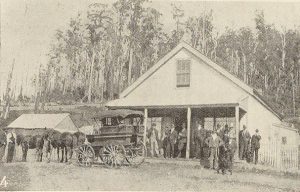
TJ Clerke’s Wilmot store, Percy Lodge photo from the Weekly Courier, 22 April 1905, p.19.
George Coles (1855–1931) was the Wilmot storekeeper whose sons, including George James Coles (1885–1977), started the chain of Coles stores in Collingwood, Victoria.[24] George Coles bought TJ Clerke’s Wilmot store in 1912, operating it until after World War One. In 1921 the store was totally destroyed by fire, although a general store has continued to operate on the same site up to the present.[25] The five skins in George Coles’ possession had probably been traded by a hunter for stores. Coles probably sold them to a visiting skin buyer when the opportunity arose.[26]
John Augustus (Jack) Linnane (1873–1949) was born at Ulverstone but arrived in the Wilmot district in 1893 at the age of nineteen, becoming a farmer there.[27] Like George Francis, Linnane joined the search party for missing hunter Bert Hanson at Cradle Mountain in 1905, suggesting that he knew the country well.[28] His abandoned hunting camp near the base of Mount Kate was still visible in 1908.[29] Enough remained to show that Linnane was one of the first to adopt the skin shed chimney for drying skins.[30] He also engaged in rabbit trapping.[31] In 1914 he was listed on the electoral roll as a Wilmot labourer, but exactly where he was hunting at that time is unknown.[32]
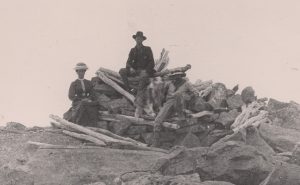
Kate Weindorfer, Ronald Smith and WM Black on top of Cradle Mountain, 4 January 1910. Gustav Weindorfer photo courtesy of the late Charles Smith.
Walter Malcolm (WM) Black (1864–1923) was a gold miner and hunter at the Lea River/Black Bluff Gold Mine in the years 1905–15. The son of Victorian grazier Archibald Black, WM Black was a ‘remittance man’, that is, he was paid to stay away from his family under the terms an out-of-court payment of £7124 from his father’s will.[33] He joined the First Remounts (Australian Imperial Force) in October 1915 by falsifying his age in order to qualify.[34] See my earlier blog ‘The rain on the plain falls mainly outside the gauge, or how a black sheep brought meteorology to Middlesex’.[35]
James Perry (1871–1948), brother of a well-known Middlesex area hunter, Tom Perry (1869–1928), who was active in the high country by about 1905. Whether James Perry’s few skins were taken around Wilmot or further afield is unknown.
No tigers at Middlesex/Cradle Mountain?
George Francis survived the financial setback of 1914. Gustav Weindorfer in his diaries alluded to collaboration with him on prospecting and mining activities, but they hunted in different areas. In 1919 Francis co-authored the three-part paper ‘Wild life in Tasmania’ with Weindorfer, which documented their extensive knowledge of native animals, principally gained by hunting them. At the time, the authors claimed, they were the only permanent inhabitants of the Middlesex-Cradle Mountain area, boasting nine years (Weindorfer) and 50 years’ (Francis) residency. They also made the interesting claim that the ‘stupid’ wombat survived as well as it did in this area because it had no natural predators, since the thylacine did not then and probably never had frequented ‘the open bush land of these higher elevations’.[36] While this suggests that George Francis had never encountered a thylacine around Middlesex, it’s hard to believe that his father Jack Francis didn’t, especially given the story that Jack’s early foray into the Vale of Belvoir as a shepherd for William Kimberley was tiger-riddled.[37] It’s also a pity the authors didn’t consult the likes of Middlesex tiger slayers Charlie McCoy (see above) and James Mapps—or rig up a séance with the late George Augustus Robinson and James ‘Philosopher’ Smith.
The dog of GA Robinson, the so-called ‘conciliator’ of the Tasmanian Aborigines, killed a mother thylacine on the Middlesex Plains in 1830.[38] Decades later, ‘Philosopher’ Smith the mineral prospector came to regard Tiger Plain, on the northern edge of the Lea River, as the most tiger-infested place he visited during his expeditions. It was popular among the carnivores, he thought, because the Middlesex stockman’s dogs by driving game in that direction provided a ready food source. ‘I thought it necessary’, he wrote about his experience with tigers,
‘to be on my guard against them by keeping a fire as much as I could and having at hand a weapon with which to defend myself in the event of being attacked by one or more of them … ‘[39]
Smith killed a female tiger on Tiger Plain and took its four pups from her pouch but found they could not digest prospector food (presumably damper, potatoes, bully beef, wallaby or wombat).[40] Philosopher’s son Ron Smith had no reason to doubt his father, as he found a thylacine skull on his property at Cradle Valley in 1913 which is now lodged in Launceston’s Queen Victoria Museum and Art Gallery.[41] There were still tigers in the Middlesex region at the cusp of the twentieth century. Like ‘Tibbly’ McCoy, James Mapps claimed a government thylacine bounty at this time, probably while working as a tributor at the Glynn Gold Mine at the top of the Five Mile Rise near Middlesex.[42]
George Francis in his will described himself as a ‘shepherd of Middlesex Plains’, yet he met his maker in the Campbell Town Hospital. His parents were dead and he had no remaining relatives. The sole beneficiary of his will was Golconda farmer and road contractor William Thomas Knight (1862–1938), probably an old hunting mate.[43] Francis’s job at Middlesex was filled by the so-called ‘mystery man’ Dave Courtney (see my blog ‘Eskimos and polar bears: Dave Courtney comes in from the cold’), whose life, as it turns out, is an open book compared to that of his elusive predecessor.
[1] Died 11 October 1883, death record no.167/1883, registered at Deloraine, RGD35/1/52 (TAHO), https://librariestas.ent.sirsidynix.net.au/client/en_AU/names/search/results?qu=maria&qu=francis#, accessed 15 February 2020; inquest dated 13 October 1883, SC195/1/63/8739 (TAHO), https://stors.tas.gov.au/SC195-1-63-8739, accessed 15 February 2020. A pre-inquest newspaper reporter incorrectly attributed her death to suicide by strychnine poisoning (editorial, Launceston Examiner, 23 October 1883, p.1).
[2] It is likely that Jack Francis and Gads Hill stockman Harry Stanley conveyed Maria Francis’s body to Gads Hill Station, where Roden took delivery of it. See ‘A veteran drover’, Examiner, 7 March 1912, p.4; and ‘Supposed case of poisoning at Chudleigh’, Launceston Examiner, 13 October 1883, p.2. Later Roden had the job of removing Stanley’s body for an inquest at Chudleigh (Dan Griffin, ‘Deloraine’, Tasmanian Mail, 13 August 1898, p.26).
[3][3] For the land grant, see Deeds of land grants, Lot 5654RD1/1/069–71In 1890, 1892 and 1894 John and George Francis were both listed as farmers at Mole Creek (Wise’s Tasmanian Post Office directory, 1890–91, p.200; 1892–93, p.288; 1894–95, p.260). Jack Francis was reported to have left Middlesex in March 1885, being replaced by Jacky Brown (James Rowe to James Norton Smith, 10 March 1885; and to RA Murray, 24 September 1885, VDL22/1/13 [TAHO]). However, he appears to have returned periodically.
[4] She was born to splitter John Wilcox and Rosetta Graves at Longford on 17 July 1841, birth record no.3183/1847 (sic), registered at Longford, RGD32/1/3 (TAHO), https://librariestas.ent.sirsidynix.net.au/client/en_AU/all/search/results?qu=sarah&qu=wilcox, accessed 14 March 2020; died 25 October 1915 at Launceston (‘Deaths’, Examiner, 8 November 1915, p.1). Mary Ann’s youngest child, Eva Grace Lowe, was born in 1879.
[5] Frank Styant Browne, Voyages in a caravan: the illustrated logs of Frank Styant Browne (ed. Paul AC Richards, Barbara Valentine and Peter Richardson), Launceston Library, Brobok and Friends of the Library, 2002, p.84.
[6] Wise’s Tasmanian Post Office directory for the period 1901–08 listed Jack Francis as an overseer at Gads Hill or Liena, while Mary, as she was described, was listed as a farmer at Liena, meaning Circular Ponds (1901, p.322; 1902, p.341; 1904, p.204; 1906, p.189; 1907, p.192; 1908, p.197).
[7] ‘A veteran drover’.
[8] ‘Return thanks’, Examiner, 2 March 1912, p.1; purchase grant, vol.36, folio 116, application no.3454 RP, 1 July 1912.
[9] Jack Francis bought purchase grant vol.18, folio 113, Lot 5654, on 25 November 1872. He divided it in half, selling the two lots on 6 May 1902 to Arthur Joseph How and Andrew Ambrose How for £30 each.
[10] ‘The mountain mystery: search for Bert Hanson’, North Western Advocate and the Emu Bay Times, 1 August 1905, p.3.
[11] 1 August 1914, ‘Daily Record of Crime Occurrences Sheffield 1901–1916’, POL386/1/1 (TAHO).
[12] See ‘William Aylett: career bushman’ in Simon Cubit and Nic Haygarth, Mountain men: stories from the Tasmanian high country, Forty South Publishing, Hobart, 2015, pp.42–43.
[13] See ‘Bert Nichols: hunter and overland track pioneer’, in Simon Cubit and Nic Haygarth, Mountain men: stories from the Tasmanian high country, Forty South Publishing, Hobart, 2015, p.114.
[14] See ‘Paddy Hartnett: bushman and highland guide’, in Simon Cubit and Nic Haygarth, Mountain men: stories from the Tasmanian high country, Forty South Publishing, Hobart, 2015, p.93.
[15] On 20 April 1892 (p.179) Frank Brown reported stolen a horse which was kept at Gads Hill, Deloraine Police felony reports, POL126/1/2 (TAHO).
[16] ‘Well-known stockrider’s death’, Advocate, 4 June 1923, p.2.
[17] ‘Lorinna’, North West Post, 28 August 1912, p.2; ‘Obituary: Mr DW Thomas, Railton’, Advocate, 21 April 1932, p.2.
[18] Born 21 March 1879, birth record no.2069, registered at Port Sorell, RGD33/1/57 (TAHO), https://librariestas.ent.sirsidynix.net.au/client/en_AU/names/search/results?qu=william&qu=ernest&qu=mccoy. Accessed 10 April 2020.
[19] Born 26 June 1870, birth record no.1409/1870, registered at Port Sorell, RGD33/1/48 (TAHO), https://librariestas.ent.sirsidynix.net.au/client/en_AU/names/search/results?qu=charles&qu=mccoy, accessed 15 September 2019; died 23 September 1962, buried in the Claude Road Methodist Cemetery (TAMIOT). For John McCoy as a convict tried at Perth, Scotland in 1792 and transported on the Pitt in 1811, see Australian convict musters, 1811, p.196, microfilm HO10, pieces 5, 19‒20, 32‒51 (National Archives of the UK, Kew, England).
[20] Born 26 June 1870, birth record no.1409/1870, registered at Port Sorell, RGD33/1/48 (TAHO), https://librariestas.ent.sirsidynix.net.au/client/en_AU/names/search/results?qu=charles&qu=mccoy, accessed 15 September 2019; died 23 September 1962, buried in the Claude Road Methodist Cemetery (TAMIOT). For John McCoy as a convict tried at Perth, Scotland in 1792 and transported on the Pitt in 1811, see Australian convict musters, 1811, p.196, microfilm HO10, pieces 5, 19‒20, 32‒51 (National Archives of the UK, Kew, England).
[21] 30 December 1901, ‘Daily Record of Crime Occurrences Sheffield 1901–1916’, POL386/1/1 (TAHO).
[22] Gustav Weindorfer diaries, 1914, NS234/27/1/4 (TAHO).
[23] Commonwealth Electoral Roll, Division of Wilmot, Subdivision of Kentish, 1914, p.27.
[24] ‘About people’, Age, 22 December 1931, p.8.
[25] ‘Fire at Sheffield [sic]’, Mercury, 8 November 1921, p.5.
[26] Coles held a tanner’s licence in 1914 (‘Tanners’ licences’, Tasmania Police Gazette, 1 May 1914, p.109), but the legal requirement was that skins had to be sold to a registered skin buyer. Despite this, plenty of people tanned and sold their own skins privately.
[27] ‘”Back to Wilmot” celebration’, Advocate, 12 April 1948, p.2.
[28] 10 July 1905, ‘Daily Record of Crime Occurrences Sheffield 1901–1916’, POL386/1/1 (TAHO).
[29] Ronald Smith, account of trip to Cradle Mountain with Bob and Ted Addams, January 1908, held by Peter Smith, Legana.
[30] Ronald Smith, account of trip to Cradle Mountain with Bob and Ted Addams, January 1908, held by Peter Smith, Legana.
[31] On 18 April 1910, Linnane reported the theft of 200 rabbit skins from his hut valued at £2, ‘Daily Record of Crime Occurrences Sheffield 1901–1916’, POL386/1/1 (TAHO).
[32] Commonwealth Electoral Roll, Division of Wilmot, Subdivision of Kentish, 1914, p.26.
[33] ‘Supreme Court’, Age, 27 February 1885, p.6.
[34] World War One service record, https://www.awm.gov.au/people/rolls/R1791278/, accessed 22 March 2020.
[35] Nic Haygarth website, http://nichaygarth.com/index.php/tag/walter-malcom-black/, accessed 22 March 2020.
[36] G Weindorfer and G Francis, ‘Wild life in Tasmania’, Victorian Naturalist, vol.36, March 1920, p.158.
[37] ‘The Tramp’ (Dan Griffin), ’In the Vale of Belvoir’, Mercury, 15 February 1897, p.2.
[38] George Augustus Robinson, Friendly mission: the Tasmanian journals and papers of George Augustus Robinson, 1829-1834 (ed. Brian Plomley), Tasmanian Historical Research Association, Hobart, 1966; 22 August 1830, p.159.
[39] James Smith to James Fenton, 14 November 1890, no.450, NS234/ 2/1/15 (TAHO).
[40] ‘JS (Forth)’ (James Smith), ‘Tasmanian tigers’, Launceston Examiner, 22 November 1862, p.2.
[41] Ron Smith to Kathie Carruthers, 26 September 1911, NS234/22/1/1 (TAHO); email from Tammy Gordon, QVMAG, 2019.
[42] Bounty no.242, 30 August 1898, LSD247/1/ 2 (TAHO); ‘Court of Mines’, Launceston Examiner, 22 September 1897, p.3; 30 September 1897, p.3.
[43] Will no.14589, administered 7 March 1924, AD960/1/48, p.189 (TAHO), https://librariestas.ent.sirsidynix.net.au/client/en_AU/names/search/results?qu=george&qu=francis, accessed 15 March 2020; ‘Funeral of Mr WF [sic] Knight’, Examiner, 15 April 1938, p.15.
by Nic Haygarth | 21/03/19 | Story of the thylacine, Tasmanian high country history
They weren’t old lags, shifty safe-crackers or Hibernian highwaymen. They were Tasmanian highland snarers who flitted across the public record, leaving just their nicknames to tantalise the curious. ‘Five-fingered Tom’ was a little light fingered. ‘Black Harry’ was dark-skinned aberration in a white society. These traits help us to flesh out the legends of two early fur hunters who might otherwise have stayed as insubstantial as the Holy Ghost.
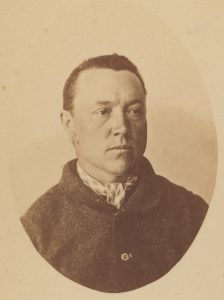
‘Five-fingered Tom’ Jeffries, photographed at the Hobart Penitentiary in 1873 by Thomas J Nevin. Courtesy of the National Library of Australia.
‘Five-fingered Tom’ was Thomas Jeffries. He was born as the second of three children to ex-convicts Thomas Jeffries and Ann Jeffries, née Willis, at Patersons Plains near Launceston in 1841.[1] His father was an illiterate labourer. Thomas Jeffries junior was born with an extra digit on his right hand (that is, five fingers and a thumb), hence ‘Five-fingered Tom’. This made him easily identifiable—good news for the cops! Jeffries regarded Evandale as his native place, but he was living and working on farms in the Sassafras area when in 1873 a warrant was issued for his arrest. The wanted man was described as about 35 years old, 5 feet 9 inches tall, with sandy hair, beard and moustache and a stout build, being ‘a good bushman [who] has spent much of his time hunting’.[2] First offender Jeffries was sentenced to eight years’ gaol for horse stealing. He spent four months making shoes in the Launceston Gaol, from which he vowed that he would abscond at the first opportunity—earning him a transfer to the Hobart Penitentiary.[3] What luck! Since Hobart prisoners were routinely photographed by Thomas J Nevin, we have the image of Jeffries attached to this article. He must have shucked off his bad attitude, since he served only five of his eight years.[4]
Like Jerry Aylett of Parkham, ‘Five-Finger Tom the Hunter’ moved into the high country by the 1880s, a time when Tasmanian brush possum had gained an export market.[5] Possum-skin rugs had been a useful earner for bushmen for decades but now the thicker highland furs had a reputation in the British Isles. In 1883 the ‘Tasmanian Opossum Tail Rug’ could be found alongside the ‘Grey Wolf Rug’, the ‘Silver Bear Rug’, the ‘Leopard, on Bear’ and the ‘Raccoon Tail Rug’ in the catalogue of Liverpool enterprise Frisby, Dyke and Co.[6] Lewis’s in Sheffield, Nottinghamshire, offered ‘real Tasmanian opossum capes’.[7] An 1887 ‘Rich winter fur’ auction in Dundee, Scotland, placed ‘Australian and Tasmanian Opossum’ alongside sealskin, sable, skunk, brown and polar bear, llama, leopard, puma, tiger and raccoon furs.[8]
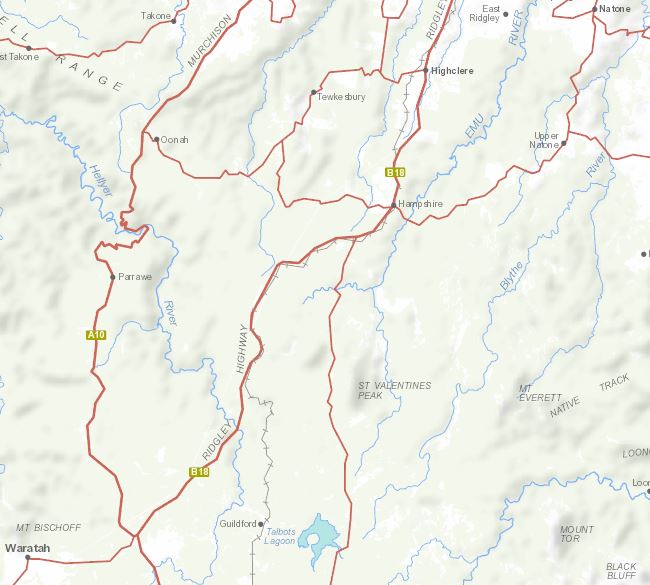
The Hampshire and Surrey Hills, Tasmania, map from the LIST database, courtesy of DPIPWE.
Waratah, a town born in the early 1870s at the Mount Bischoff tin mine, was a staging-post for both prospectors and hunters. We can follow Jeffries there in 1886 through the digitised pages of the Tasmania Police Gazette. He seems to have found it hard to stay out of trouble, allegedly committing an assault at Waratah before making for the hunting grounds of the Middlesex Plains.[9] Guildford Junction, a village created by the extension of the Emu Bay Railway to Zeehan in the late 1890s, was another hub for bushmen such as Van Diemen’s Land Company (VDL Co) timber splitters, hunters and prospectors. Jeffries and his mate Bill Todd were both based there in the period 1903–05, joining fellow hunters ‘Black Harry’ Williams, Tom Allen, the ‘Squire of Guildford’ Edward Brown and, from 1904, Luke Etchell.[10] They had a wide orbit. Todd, for example, was prospecting with George Sloane on the February Plains in 1901 when the latter discovered the body of lost Rosebery hotelier Thomas (TJ) Connolly.[11] Shopkeeper Allen packed stores into the Mayday gold mine under the Black Bluff Range in 1902.[12]
In the years 1888–1909 most of these men supplemented their income by claiming the £1 bounty on the head of the thylacine or Tasmanian tiger. Tom Allen appears to have received fifteen bounty payments—although, as a storekeeper and skins dealer, he may have submitted some applications on behalf of other hunters.[13]
Not so ‘Black Harry’ Williams, the so-called ‘colored king of the forest’, who probably claimed four tiger bounties.[14] He was a short, black-haired Afro-American bush farmer and hunter who arrived in Wynyard in 1887 aged about 24. After serving a month’s gaol for poaching neighbourhood ducks, Williams (‘A black man’!) started operating south of Wynyard (pre-1900), and later at Natone, Hampshire, Guildford and the Hatfield Plains (1900–08).[15] He caught two tigers at the Hampshire Hills in 1900, exhibiting a living one in Burnie. His intention was to sell it to Wirth’s Circus.[16] ‘Black Harry’ was reported to be submitting the other specimen, a very large dead one, for the thylacine bounty, although there is no record of this application.[17] Just enough details of his life survive with which to tell a story. In 1901 he was sued by Chinese storekeeper Jim Sing for failing to pay for a bag of carrots delivered to the Hampshire Hills; Williams counter-sued over Sing’s failure to pay for 100 wallaby skins delivered to Waratah by the hunter.[18] Three years later he was accused of breaking down a VDL Co stockyard at Romney Marsh near the Hatfield River in order to use the timber in a drying shed—making him an early adaptor of this technology (today Black Harry Road recalls his presence in this area). In 1905 Williams was described as the ‘champion trapper and bushman of the State’, the ideal man to lead a search for hunter Bert Hanson who went missing near Cradle Mountain.[19]
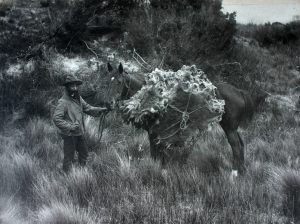
Wallaby hunter Henry Grave demonstrating his reliance on his horse as a pack animal, King Island, 1887. Photo by Archibald J Campbell, courtesy of Museums Victoria.
Jeffries may have been a contender for those honours. Knowledge of his hunting around Cradle Mountain with Todd—another man who flits across the public record—was passed down through generations of bushmen. Drawing on this oral record in 1936, Cradle Mountain Reserve Secretary Ronald Smith unwittingly fused the characters into Tom Todd, aka ‘Five-fingered Tom’. It was on the edge of the high plain they hunted, known as Todds Country, that Hanson died in a blizzard.[20] Correcting Smith’s article, another writer recalled that ‘Tom Jeffrey’ and his Arab pony Dolly were known for many years between Middlesex and Waratah, his mount being ‘the most faithful and gamest bit of horseflesh that ever packed a load over the Black Bluff’.[21] The winter haunts of the highland snarer were very cold, very wet and poorly charted, his comforts simple and meagre, his rewards contingent upon government regulation and global demand. Often he was unseen for months at a time. No newspaper trumpeted his story. Perhaps an extra digit and a different pigment were all that kept Jeffries and Williams from historical anonymity—but I hope there is a lot more to their stories that hasn’t yet been teased out.
[1] Thomas Jeffries senior, transported on the Georgiana, was granted permission to marry Ann Willis, transported on the New Grove, on 3 October 1838, p.88, CON52/1/1; Thomas Jeffries junior was born to Thomas and Ann Jeffries on 1 November 1841, birth record no.1848/1842, registered at Launceston, RGD32/1/3 (TAHO). He had elder and younger sisters: Mary Ann Jeffries, born 24 October 1839, birth record no.1021/1840, registered at Launceston, RGD32/1/3, address was given as Watery Plains; Maria Jeffries, born 11 June 1844, no.271/1844, registered at Launceston, RGD33/1/23 (TAHO).
[2] ‘Warrants issued, and now in this office’, Reports of Crime, 23 May 1873, vol.12, no.723, p.86.
[3] Prison record for Thomas Jeffries, image 25, p.11, CON94/1/2 (TAHO).
[4] ‘Prisoners discharged from Her Majesty’s gaols …’, Reports of Crime, 27 September 1878, vol.17, no.1001, p.157.
[5] See, for example, ‘Commercial’, Launceston Examiner, 24 November 1886, p.2; 19 April 1890, p.2. While William Turner failed to attract a reasonable price for Tasmanian brush possum from English buyers in 1871 (William Turner to the Colonial Treasurer, 27 September and 17 December 1872, TRE1/1/462 [TAHO]), in 1883 HE Button of Launceston began to ship furs to London: ‘Open fur season’, Mercury, 30 July 1926, p.3. For William ‘Jerry’ Aylett, see Nic Haygarth, ‘William Aylett: career bushman’, in Simon Cubit and Nic Haygarth, Mountain men: stories from the Tasmanian high country, Forty South Publishing, Hobart, 2015, pp.28–55.
[6] Frisby, Dyke and Co advert, Liverpool Mercury, 12 November 1883, p.3.
[7] ‘Lewis’s great sale of mantels and furs’, Sheffield Daily Telegraph, 5 February 1886, p.1.
[8] ‘Sales by auction’, Dundee Courier and Argus, 19 November 1887, p.1.
[9] ‘Waratah’, Tasmania Police Gazette, 19 November 1886, vol.25, no.1426, p.187.
[10] Wise’s Tasmanian Post Office directory, 1903, p.56; 1904, p.412; 1905, p.61.
[11] ‘”Lost and perished in the snow”: another Cradle Mountain tragedy’, Advocate, 27 March 1936, p.11.
[12] Thomas Allen to James Norton Smith, Van Diemen’s Land Company, 28 January 1902, VDL22/1/33 (TAHO).
[13] Bounty no.374, 12 January 1899 (3 adults, ‘3 December’); no.401, 15 November 1900 (3 adults, ’15 June’); no.482, 21 January 1901 (3 adults, ’17 December’); no.22, 4 February 1901 (3 adults, ‘4 January’); no.985, 25 July 1902 (‘July’); no.1057, 27 August 1902 (’15 August’); no.1091, 17 September 1902 (‘4 September 1902’); no.462, 6 August 1903, (1 juvenile, ’24 July’), LSD247/1/ 2 (TAHO). See ‘Burnie’, North Western Advocate and the Emu Bay Times, 15 December 1900, p.2.
[14] ‘Veritas’, ‘The lost youth Bert Hanson’, North Western Advocate and the Emu Bay Times, 11 August 1905, p.2. The bounties were all under the name ‘H Williams’: no.344, 17 November 1899 (’10 October’); no.1078, 11 September 1902 (’31 July 1902’); no.1280, 2 December 1902; no.76, 20 February 1903 (’14 February 1903’), LSD247/1/2 (TAHO).
[15] Williams’ activities at Wynyard in 1887 and 1889 were recorded in the diaries of George Easton, held by Libby Mercer (Hobart). For his conviction on a larceny charge, see ‘Wynyard’, Colonist, 12 October 1889, p.2; and ‘Prisoners discharged …’, Tasmania Police Gazette, 8 November 1889, vol.28, no.1581, p.180. Wise’s Tasmanian Post Office directory listed H Williams as a hunter living at Wynyard in 1900 (p.223), 1901 (p.239) and 1902 (p.255). Yet he caught two tigers at the Hampshire Hills (Hampshire) in 1900. In June 1903 he advertised for sale a 50-acre farm on Moores Plain Road south of Wynyard (‘For sale’, North Western Advocate and the Emu Bay Times, 1 June 1903, p.3), and in the period 1903–08 he had a mortgage on a 98-acre block at Natone near Hampshire, which would have been a handy base for his hunting activities (Assessment rolls, Hobart Gazette, 8 December 1903, p.2080; 5 December 1905, p.1847; Tasmanian Government Gazette, 12 November 1907, p.1951; and 30 June 1908, p.739). Wise’s Tasmanian Post Office directory placed him at Guildford Junction in 1905 (p.61) and 1906 (p.61). ‘Veritas’ placed him at the Hatfield Plains south-east of Waratah in 1905 (‘Veritas’, ‘The lost youth Bert Hanson’).
[16] ‘Burnie’, North Western Advocate and the Emu Bay Times, 21 November 1900, p.2.
[17] ‘Inland wires’, Examiner, 14 December 1900, p.7.
[18] ‘Burnie’, North Western Advocate and the Emu Bay Times, 18 October 1901, p.2.
[19] ‘Veritas’, ‘The lost youth Bert Hanson’.
[20] Ronald Smith, ‘Scene of hunter’s tragic death’, Mercury, 21 March 1936, p.9.
[21] ‘BEG’, ‘Cradle Mountain memories’, Advocate, 24 March 1936, p.6.
by Nic Haygarth | 20/12/16 | Circular Head history, Story of the thylacine, Tasmanian high country history
Ever felt the need to turn the orthodox version of history on its head, and look at it upside down? Sometimes I want to write history from the ground up, from the perspective of people at the bottom of the food chain. With that in mind, I once set out to try to prove that the Van Diemen’s Land Company (VDL Co) was primarily a fur farmer during its first century, that is, that more money was generated by the culling of marsupials on its land than by grazing and agriculture. Unfortunately, there are few surviving records of the skins sales of disparate hunter-stockmen employed by the company, making the task very difficult.
That the VDL Co learned to exploit the fur trade emphasises that the company’s survival for nearly 200 years has pivoted on its flexibility. When wool-growing failed, it withdrew, leased its lands and waited for the right time to return as a wool, dairy, beef, timber and brick producer. When it could find no minerals on its lands, it built a port and established a railway so that it could exploit other people’s mineral exports. It sold its land and its timber. When the fur trade peaked in the 1920s it exploited that. Now it is referred to as Australia’s biggest dairy farmer. Is high-end heritage tourism or Chinese niche tourism the next chapter in the story of Woolnorth, the VDL Co’s remaining property?
Just to rewind a little, the hunter-stockmen who worked the VDL Co’s land had always exploited the fur trade. It was part of their employment obligations: we pay you a small wage, thus giving you the incentive to increase your income by killing all the grass-eating marsupials and all potential predators (tigers, wild dogs and eagles) of sheep, and thereby conferring a mutual benefit. You sell the marsupial skins, and we will even throw in a bounty for every predator you kill.
The killing of predators represented a bonus for hunter-stockmen whose main game was killing wallabies, pademelons and possums. By 1830 thylacines were being blamed for killing the company’s sheep, although it is clear that poor pasture selection and wild dogs were bigger problems. After the catastrophic loss of 3674 sheep at the Hampshire and Surrey Hills in the years 1831–33 to severe weather conditions and the attacks of wild animals, it was decided to temporarily cease grazing sheep there, transferring that stock to Circular Head and Woolnorth.[1] In 1830 a £1 bounty was offered for the killing of a particular thylacine at Woolnorth.[2] From 1831 the VDL Co paid a regular reward for killing thylacines on its properties, initially 8 shillings, later 10.[3] The Court of Directors in London seemed to panic about the company’s prospects, stating that ‘We fear the hyenas and wild dogs, more than climate’.[4] The dilemma of the dog problem is clear. Requests for a thylacine-killing dog for Woolnorth were matched by reports of sheep depredations of dogs belonging to Woolnorth servants.[5] In 1835–37 the VDL Co employed a dedicated ‘pest controller’, James Lucas, to kill wild dogs and thylacines at first at the Hampshire and Surrey Hills, then at Woolnorth.[6] Lucas, a ticket-of-leave convict, could be said to have been the first Woolnorth ‘tigerman’, although he was never referred to by that name and was employed there only briefly.[7] He operated on the same thylacine bounty of half a guinea. Whether due to Lucas’ performance or other influences, stock losses at Woolnorth dropped dramatically during his time there and the panic over thylacines and wild dogs subsided. However, bounty payments for the killing of predators had been resumed by 1850, as the following table illustrates:
Rewards paid by the VDL Co for the killing of predators at Woolnorth 1850–51
| Name |
Time |
Program |
Kill |
Payment |
| Edward Marsh |
Aug 1850 |
Merino sheep |
Hyena |
5 shillings |
| A Walker |
Aug 1850 |
Merino sheep |
Two hyenas |
10 shillings |
| Richard Molds |
Aug 1850 |
Cross bred Leicester sheep |
Three dogs |
15 shillings[8] |
| A Walker |
Nov 1850 |
Improved sheep |
Hyena |
£1-2-11[9] |
| Richard Molds |
Feb 1851 |
Leicester sheep |
Dog |
5 shillings[10] |
| A Walker |
Sep 1851 |
Merino sheep |
Hyena & Two Eagle Hawks |
4 shillings 6d[11] |
| W Procter |
Dec 1851 |
Woolnorth |
Hyenas |
10 shillings[12] |
VDL Co withdrawal and the Field brothers on the Surrey Hills
In 1852 the VDL Co withdrew from Van Diemen’s Land, becoming an absentee landlord and, by 1858, its Hampshire and Surrey Hills and Middlesex Plains blocks were all leased to the Field family graziers. Tasmanian furs were already renowned, even before a market was found for them in London. Tasmanian bushmen and excursionists favoured possum-skin rugs as bedding. The best brush possum rugs to be had in Melbourne were reputedly those made by Tasmanian shepherds from snared skins, where the animals grew larger and more handsome than their Victorian counterparts.[13]
Fields’ outposted hunter-stockmen invariably hunted for meat, skins and clothing, burning off the surrounding scrub and grasslands to attract game. When an 1871 party visited the Hampshire Hills station, the peg-legged Jemmy, who was the designated cook, whipped up wallaby steaks. At the Surrey Hills, Charlie Drury, a delusional ex-convict hunter-stockman whom Fields inherited from the VDL Co, fed them cold beef, and the visitors got to try those famous possum-skin rugs, which, as was customary, were alive with fleas. While his guests battled these, Drury went ‘badger’ (wombat) hunting by the light of the moon with about a dozen kangaroo-dogs, bringing home three skins and one entire animal—presumably for breakfast. As he explained at the dining table, ‘the morning after I have been out badger-hunting at night I always eat two pounds of meat for breakfast, to make up for the waste created by want of sleep’. Travelling further, the party found that Jack Francis, stockman at Middlesex Plains, made his family’s boots and shoes from tanned hides. He also tanned brush possum skins for rugs, which again formed the bedding—flealessly this time.[14]
Records of hunter-stockman sales of skins from this period are scant. A rare example is an account in the VDL Co papers of its Mount Cameron West ‘tigerman’ William Forward sending 180 wallaby and 84 pademelon skins to market in April 1879.[15] In 1879 the open season for ‘kangaroo’ (wallaby) was from 31 January to 31 July, suggesting that Forward’s haul represented at most two months’ worth out of a six-month season.[16] By market prices of the time these skins would have been worth at least £8–4–0 and at most £14–14–0. If we assume that his haul for the six-month season was three times as much, we can imagine him earning at least as much as his annual wage of £20–£30. And that is without bonuses for thylacine killings.
Luke Etchell, career bushman
While Charlie Drury was drinking himself to death at his hunting hut on Knole Plain, and the VDL Co plotting the removal of Fields and all their wild cattle from the Hampshire and Surrey Hills, Luke Etchell was a child growing up fast. He was the son of John Etchell or Etchels, a transported ex-convict harking from rural Lancashire. How many of the sins of the father were visited on the son? By the time of his transportation at the age of fifteen, John Etchell had already racked up convictions for housebreaking, theft, assault and, perhaps most telling of all, vagrancy. He was illiterate.[17] While still a convict in Van Diemen’s Land, he twice saved someone from drowning. [18] However, the negative side of the ledger kept him in the convict system. Christopher Matthew Mark Luke Etchell—a child with most of the Gospels and more—was born to John and Mary Ann Etchell, née Galvin, at Stanley, on 17 December 1868, as perhaps their fourth child.[19] (The origins of Mary Ann Galvin or Galvan have so far proven elusive.[20]) His family lived in a hut at Brickmakers Bay which was destroyed by fire in 1874, then appears to have moved to Black River, at a time when payable tin had been found at Mount Bischoff and specks of gold in west- and north-flowing rivers.[21] John Etchell worked as a labourer, a paling splitter and a prospector who claimed to have found gold eighteen km south-east of Circular Head in 1878.[22]
Life was not harmonious or easy, however, as suggested by Mary Ann Etchell’s successful application for a protection order against her husband in August 1880. In the court proceedings she alleged that about a year earlier he had threatened to sell everything in order to raise money to get him to Melbourne, where she supposed he was now. For the last five months all he had contributed for the upkeep of his family was 228 lb (103 kg) of flour and one bag of potatoes. [23] It seems that the family never saw John Etchell again and, given the request for a protection order, they were probably glad about it.
Certainly Luke Etchell became self-reliant very quickly. He claimed that at the age of nine, that is, in 1877, he was already working in a tin mine on Mount Bischoff and at one of the stamper batteries at the Waratah Falls, and it is true that, almost in the Cornish tradition, young boys found mining work of this kind.[24] (One of his contemporaries as a bushman, William Aylett, born in 1863, claimed to have been learning how to dress tin at Bischoff at the age of thirteen in 1876.[25]) His English-born relative John Wesley Etchell was certainly established in Waratah by December 1878, operating a shop owned by the ubiquitous west coaster JJ Gaffney, and the family made the move there, presumably with John Wesley Etchell as the major breadwinner. [26] Luke, like some of his brothers and sisters, had at least one brush with the law in his youth.[27]
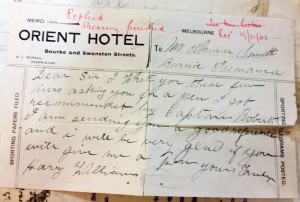
Even ‘Black’ Harry Williams the tiger killer needed to go shearing for additional income. Here he asks the VLD Co for a shearing pen in 1901. From VDL22-1-31 (TAHO).
Etchell was probably with his family at Waratah until at least 1886, when he was eighteen. Over the next two decades he became an expert bushman, apparently commanding familiarity with all the country between the lower Pieman River and Cradle Mountain.[28] His base was at Guildford Junction, the village centred on the junction of the VDL Co’s lines to Waratah and Zeehan, on the hunting territory of the Surrey Hills. He also became handy with his fists, featuring in a public boxing match in 1902.[29] Other hunters, successors to Drury, were working the Surrey and Hampshire Hills. By 1900 ‘Black’ Harry Williams, for example, the ‘colored [sic] king of the forest’, was building a reputation as a tiger tamer on the Hampshire Hills, even showing a live one in Burnie which he intended to sell to Wirth’s Circus.[30] Williams probably collected four government thylacine bounties, whereas Etchell collected only one, in 1903, most of his incidental tiger kills coming after the bounty was abolished.[31]
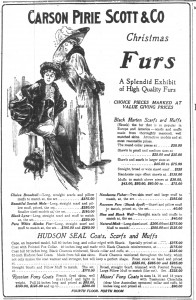
In 1910 ‘Tasmanian Chinchilla (clear blue Australian possum)’ took its place in the American fur catalogue alongside Hudson seal, skunk, beaver, wolf and chamois. Advert from the Chicago Daily Tribune, 17 December 1910, p.26
By 1905 Etchell was sufficiently well known as a bushman of the high country to be recommended as the man to lead a search for Bert Hanson, the seventeen-year-old lost in a blizzard on the eastern side of Dove Lake.[32] Making a living as a bushman meant grasping every opportunity that came along, be it splitting palings, cutting railway sleepers, taking a contract to build or repair a road or working an osmiridium claim. In 1910, for example, Etchell’s £30 tender for work on the road at Bunkers Hill was accepted by the Waratah Council.[33] In 1912 he obtained a tanner’s licence, suggesting that he intended to deal in skins.[34]
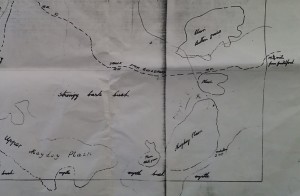
‘X’ marks the spot. The Etchell Mayday (First of May) Plain hut raided by police in 1937 in the south-western corner of the Surrey Hills block. Note also the prospectors’ camp marked nearby. From AA612/1/5 (TAHO).
However, it was as a snarer that Etchell made his reputation. He would have learned how to hunt as a boy from his father or brothers. Like the Ayletts, the Etchell family dealt extensively in the fur trade. Luke’s brother William snared and bought skins.[35] His cousin Harold Reuben Etchell had run-ins with the law over skin dealings, being the subject of a police stake-out and raid on a hut on the Mayday Plain (now First of May Plain).[36] Ernest James Etchell was another hunter who tested or blurred the hunting regulations.[37] However, Luke struck up a partnership with his brother Thomas, who also dabbled in prospecting.[38]

Atkinson’s hut and skin shed at Thompsons Park, on the Surrey Hills block. Thompsons Park was the site of a Field brothers’ stock hut. Later it also served seasonal hunters.
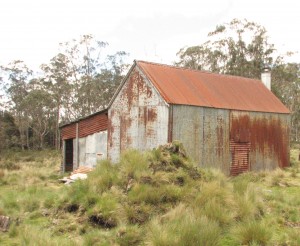
The pile of rubble or huge chimney butt beside Atkinson’s hut from a previous building on the Thompsons Park site.
As outlined previously, having hunters remove the plentiful game from its remaining land benefited the VDL Co stock—and the company gained doubly by charging these men for the privilege. The VDL Co engaged Surrey Hills hunters on a royalty system of one-sixth of their skins taken. In February 1912, for example, its Guildford man Edward Brown told its Tasmanian agent AK McGaw that Thomas Etchell had requested a run near the Fossey River, whereas R Brown wanted the 31 Mile or the West Down Plain (which turned out to be outside the Surrey Hills boundary). ‘I have told them that they must report to me before sending any of their skins away’, he wrote, ‘so I can count them and retain two out of every dozen for the company …’ [39] The disadvantage of this system for the VDL Co was that hunters could cheat, and later that season Brown claimed that DC Atkinson and Luke Etchell were not submitting all their skins to him from a lease Atkinson had taken on ‘the Park’. Brown found particular fault with their second load of skins:
‘The next lot was over 1½ cwt and Etchell gave me 11 which weighed 8 lbs and said “that was his share” but Atkinson would not give any as he caught them on his own ground. I know for sure he as [sic] snares set other than on his own ground. I think he was given the right on the conditions he gave 2 in the dozen regardless of where they were caught. Anyhow Atkinson should have given 11 and that would leave about ½ cwt to come off his own ground …’[40]
Ironically, the Animals and Birds Protection Act (1919) ushered in perhaps the greatest marsupial slaughter in Tasmanian history. In the open season winters from 1923 to 1928 about 4.5 million ringtail possum, brush possum wallaby and pademelon skins were registered.[41] It is easy to imagine why at some stage the VDL Co increased its royalty on the Surrey Hills from one-sixth of all skins taken to one-third. It sent men with pack-horses around the leased runs every fortnight to collect skins. Harry Reginald Paine described a raid by police and VDL Co officers on a Waratah house owned by Joe Fagan which the company believed contained skins obtained without royalty payment from the Surrey Hills block.[42] However, the late 1920s and early 1930s were dark days economically, with only the 1931 gold price spike and government incentives like the Aid to Mining Act (1927) giving hope to rural workers. Many prospectors went looking for gold in the Great Depression years, and some got into trouble. In 1932 Luke Etchell and Cummings of Guildford sought and found the Waratah prospector WA Betts, after he was lost in the snow for two weeks. After giving him a good feed, they returned him to Guildford on horseback.[43] Again, Etchell was the man to whom people looked when someone went missing in the high country.
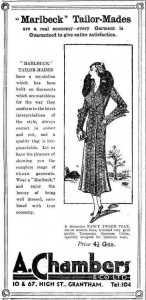
The fashionable British bride would not think of departing on her honeymoon without her Tasmanian brush possum collar coat in 1932. Advert from the Grantham Journal, 29 October 1932, p.4.
The open season of 1934, in which nearly a million-and-a-half ringtails were taken in Tasmania, was a godsend to the VDL Co which, during an unprofitable year for farming, made £500 out of hunting.[44] Thomas Etchell may not have been too wide of the mark when it predicted that an open season would benefit the community to the extent of £300,000–£400,000.[45] Did it benefit the possum population? The downside of that record-breaking season for hunters was that it was followed by two closed seasons while ringtail numbers recovered.
By the mid-1930s Luke Etchell was stockman for the shorthorn herds of RC Field’s Western Highlands Pty Ltd, which existed at least 1932‒38, and a regular correspondent with the police on hunting matters.[46] Ahead of the open season in 1937, for example, he advised Waratah’s Constable MY Donovan that ‘the Kangaroo and Wallaby were that numerous that they were eating the grass off and leaving the sheep and cattle on the runs short’.[47] Later that year, with the thylacine finally part protected and the Animals and Birds’ Protection Board keen to find living ones, Etchell was the ‘go to man’ for the Surrey Hills, Middlesex Plains, Vale of Belvoir and the upper Pieman. He suggested the hut in the Vale of Belvoir as a good base for the search.[48] He told Summers that ‘some years ago he has caught six or seven Native Tigers during a hunting season but for many years now he has not seen or caught any, proving that they have become extinct in this part, or driven further back’.[49]
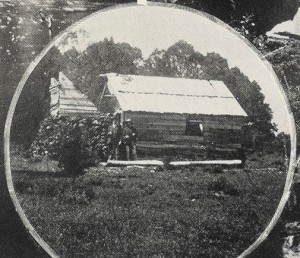
Hut in the Vale of Belvoir. AW Lord photo from the Weekly Courier, 20 July 1922, p.22.
Benefiting from Etchell’s advice, and using Thompsons Park on the Surrey Hills block as another base, the government party, consisting of Sergeant MA Summers, Trooper Higgs, Roy Marthick from Circular Head and Dave Wilson, the VDL Co’s manager at Ridgley, scoured the region near Mount Tor, around the head waters of the Leven, the Vale of Belvoir and the Vale River down to its junction with the Fury and the Devils Ravine without finding signs of thylacine activity. A further search was conducted around the Pieman River goldfield and the coast north-west of there.[50] After commenting on the large numbers of brush possums in the area searched, Summers arranged for Etchell to secure seven pairs of black possums for the Healesville Sanctuary, Victoria.[51] Again, in 1941, Etchell advised that on the Surrey Hills, ‘the kangaroo and wallaby are plentiful … and that open season would be beneficial for everyone.[52]
There were bumper hunting seasons near the end of World War II and after it, with £15,000-worth of skins sold at the sale at the Guildford Railway Station in 1943, more than 32,000 skins offered there in 1944 and record prices being paid at Guildford in 1946.[53] One party of three hunters was reported to have presented about three tons of prime skins for sale in 1943.[54] Taking advantage of high demand, in 1943 the VDL Co dispensed with the royalty payment system and made the letting of runs its sole hunting revenue—these included Painter Run (Painter Plain), Park Run (Old Park?), Mayday Run (Mayday Plain, now First of May Plain, in the furthest south-east corner of the Surrey Hills block), Talbots Run (presumably near Talbots Lagoon), Peak Run (Peak Plain), Black Marsh Run (probably near the site of the old Burghley Station), and those which probably corresponded to the mileposts on the Emu Bay Railway, the 25 Mile, 36 Mile and 46 Mile Runs. Like the traditional Cornish ‘tribute’ mining system, by which parties of men competed to work particular sections of a mine, the highest bid won the contract for each run. Men paying as much as £70 for seasonal rental of a run felt short-changed when heavy snowfalls curtailed their activities, which were still subject to the official hunting season. Nearly all the men who hunted the Surrey Hills block in 1943 combined this work with pulp wood cutting for Australian Pulp and Paper Mills (APPM) at Burnie, or another job in the timber industry. Waratah’s Trooper Billing estimated that pulp wood cutting averaged seven hours per day, compared to 16 hours per day for snaring.[55] Billing regarded the Surrey Hills block as a game-breeding ground which damaged the interests of adjacent landholders.[56]
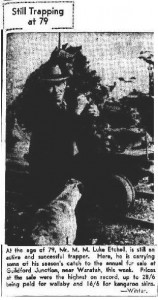
Luke Etchell posing before the Guildford skin sale in 1946. Winter photo from the Examiner, 1 August 1946, p.1.
These bumper seasons were the end of the road for the Etchell brothers. Thomas Etchell died in September 1944.[57] Brother Luke was still snaring at 78 years of age in 1946, when the Burnie photographer Winter posed him in best suit, that apparently being the outfit of choice for hauling your skins on your shoulder to the Guildford sale.[58] Luke Etchell died in Hobart on 8 June 1948.[59] There were a few good hunting season after that, but in 1953 new regulations curbed an industry already reduced by weakening European and North American demand for skins. The era of the hunter-stockman and the professional bushman—the man who could live by his nous in the bush—was drawing to a close.
[1] ‘Van Diemen’s Land Company’, Hobart Town Courier, 25 September 1835, p.4.
[2] Edward Curr to Joseph Fossey, Woolnorth manager, 12 May 1830, VDL23/3 (Tasmanian Archive and Heritage Office [henceforth TAHO]).
[3] Edward Curr to James Reeves, Woolnorth manager, 2 April 1831, VDL23/4 (TAHO).
[4] Court of Directors to JH Hutchinson, Inward Despatch no.98, 10 October 1833, VDL193/3 (TAHO).
[5] See Edward Curr to Adolphus Schayer, Woolnorth manager, 8 February 1836, 30 June 1836, 10 August 1836, 14 September 1836 and 1 February 1837, VDL23/7 (TAHO).
[6] Edward Curr to Adolphus Schayer, Woolnorth manager, 6 March 1835, VDL23/6 (TAHO).
[7] For an overview of James Lucas’ work for the VDL Co, see Robert Paddle, The last Tasmanian tiger: the history and extinction of the thylacine, Cambridge University Press, Cambridge, UK, 2000.
[8] VDL232/1/5, p.158 (TAHO).
[9] VDL232/1/5, p.158 (TAHO).
[10] VDL232/1/5, p.215 (TAHO).
[11] VDL232/1/5, p.255 (TAHO).
[12] VDL232/1/5, p.272 (TAHO).
[13] HW Wheelwright, Bush wanderings of a naturalist, Oxford University Press, 1976 (originally published 1861), p.44.
[14] Anonymous, Rough notes of journeys made in the years 1868, ’69, ’70, ’71, ’72 and ’73 in Syria, down the Tigris … and Australasia, Trubner & Co, London, 1875, pp.263–64.
[15] James Wilson to James Norton Smith, 8 April 1879, VDL22/1/7 (TAHO).
[16] ‘Notices to correspondents’, Launceston Examiner, 26 November 1879, p. 2; ‘Kangaroo hunting’, Cornwall Chronicle, 31 January 1879, p. 2.
[17] John Etchell was tried at the Derby Assizes 15 May 1843 for housebreaking, stealing money and assault, see CON33/1/53. http://search.archives.tas.gov.au/ImageViewer/image_viewer.htm?CON33-1-53,308,90,F,60 accessed 18 December 2016.
[18] Matthias Gaunt, ‘Indulgence’, Launceston Examiner, 1 December 1849, p.4.
[19] Birth registration 702/1869, Horton.
[20] Luke’s mother, Mary Ann Etchell, died at Waratah in 1903 (‘Waratah’, North Western Advocate and the Emu Bay Times, 3 October 1903, p.2).
[21] See file (SC195-1-57-7410, p.1) at https://linctas.ent.sirsidynix.net.au/client/en_AU/all/search/results?qu=john&qu=etchell# accessed 18 December 2016.
[22] ‘Mining intelligence’, Launceston Examiner, 28 September 1878, p.2. See also Charles Sprent’s dismissal of John Etchell’s alleged tin discovery at Brickmakers Bay in 1873 (Charles Sprent to James Norton Smith, 6 July 1873, VDL22/1/4 [TAHO]).
[23] ‘Stanley’, Mercury, 12 August 1880, p.3.
[24] ‘Mr Luke Etchell’, Advocate, 1 July 1948, p.2.
[25] See Nic Haygarth, ‘William Aylett: career bushman’, in Simon Cubit and Nic Haygarth, Mountain men: stories from the Tasmanian high country, Forty South Publishing, Hobart, 2015, p.28–55.
[26] Advert, Launceston Examiner, 26 February 1880, p.4.
[27] Luke and Flora Etchell were convicted of stealing potatoes at Black River in 1883 (‘Emu Bay’, Reports of Crime, 20 April 1883, p.61; ‘Miscellaneous information’, Reports of Crime, 4 May 1883, p.70). Luke’s sister Sarah Ann was convicted of concealing the birth of a still-born child in pathetic circumstances in Waratah (‘Supreme Court’, Daily Telegraph, 22 August 1884, p.3). The most serious matter was his brother Thomas Etchell’s conviction of indecent assault in Waratah (‘Supreme Court, Launceston’, Mercury, 19 February 1896, p.3).
[28] ‘The Corinna fatality’, North Western Advocate and the Emu Bay Times, 3 November 1900, p.4.
[29] Editorial, Zeehan and Dundas Herald, 24 July 1902, p.3.
[30] ‘Burnie’, North Western Advocate and the Emu Bay Times, 21 November 1900, p.2; ‘Veritas’, ‘The lost youth Bert Hanson’, North Western Advocate and the Emu Bay Times, 11 August 1905, p.2. In December 1900 Williams exhibited the skin of a tiger said to be seven feet long in Burnie (‘Burnie’, North Western Advocate and the Emu Bay Times, 25 December 1900, p.2). For another Williams tiger story, see ‘Inland wires’, Examiner, 14 December 1900, p.7.
[31] Potential Williams bounties: no.344, 17 November 1899 (’10 October’); no.1078, 11 September 1902 (’31 July 1902’); no.1280, 2 December 1902; no.76, 20 February 1903 (’14 February 1903’), (’17 March 1902’). Etchell bounty: 25 June 1903, LSD247/1/2 (TAHO).
[32] J North, ‘A Waratah man’s opinion’, North Western Advocate and the Emu Bay Times, 1 August 1905, p.3.
[33] ‘Local government: Waratah’, Daily Telegraph, 9 March 1910, p.7.
[34] ‘Tanner’s licences’, Police Gazette, 9 August 1912, p.183.
[35] For snaring see, for example, Thomas Lovell to AK McGaw, 16 July 1911, VDL22/1/47 (TAHO). For buying see for example, ‘Alleged illegal buying of skins’, Advocate, 27 July 1939, p.2.
[36] For the police raid, see Sergeant Butler to Superintendent Grant, 10 May 1937, AA612/1/12 (TAHO). See also ‘Trappers defrauded’, Mercury, 3 September 1930, p.9; and ‘Conspiracy charge’, Mercury, 4 September 1930, p.10. In 1943 police interviewed Harold Reuben Etchell in Wynyard but failed to find any illegally obtained skins (Detective Sergeant Gibbons to Superintendent Hill, 14 September 1943, AA612/1/12 [TAHO]).
[37] ‘Sheffield’, Advocate, 21 September 1937, p.6.
[38] See HS Allen to AK McGaw, 25 October 1907, VDL22/1/39 (TAHO). Thomas Etchell went osmiridium mining in 1919 during the peak period on the western field (see Pollard to the Attorney-General’s Department, 19 November 1919, p.113, HB Selby & Co file 64–2–20 [Noel Butlin Archive, Canberra]).
[39] George E Brown to AK McGaw, 20 February 1912, VDL22/1/48 (TAHO).
[40] George E Brown to AK McGaw, 27 June 1912, VDL22/1/48 (TAHO).
[41] Police Department, Report for 1925–26 to 1927–28, Parliamentary paper 41/1928, Appendix J, p.13.
[42] Harry Reginald Paine, Taking you back down the track … is about Waratah in the early days, the author, Somerset, Tas, 1992, pp.47–48.
[43] ‘Owes his life to dog’, Advocate, 13 July 1932, p.8; ‘Lost in snow for fortnight’, Advocate, 27 June 1932, p.4.
[44] VDL Co annual report 1934, Miscellaneous Printed Matter 1880‒1967, VDL334/1/1 (TAHO).
[45] T Etchells [sic], ‘Open season for game’, Examiner, 5 May 1934, p.11.
[46] ‘Personalities at the show’, Examiner, 7 October 1936, p.6. Ironically, one of his tasks now was to keep other hunters off the company’s land (see, for example, advert, Advocate, 18 January 1834, p.7) in case they endangered stock or let stock out through an open gate.
[47] MY Donovan to the Animals and Birds’ Protection Board, 12 January 1937, AA612/1/5 (TAHO).
[48] MA Summers’ report, 3 April 1937, AA612/1/59 H/60/34 (TAHO).
[49] MA Summers’ report, 14 May 1937, AA612/1/59 H/60/34 (TAHO).
[50] MA Summers’ report, 14 May 1937, AA612/1/59 H/60/34 (TAHO).
[51] ‘Opossums for Melbourne’, Advocate, 26 May 1938, p.6.
[52] Luke Etchell, ‘The game season’, Advocate, 15 May 1941, p.5.
[53] ‘£15,000 skin sale at Guildford’, Examiner, 14 October 1943, p.4; ‘Over 32,000 skins offered at sale’, Advocate, 13 September 1944, p.5; ‘Record prices at Guildford skin sale’, Advocate, 30 July 1946, p.6.
[54] ‘£15,000 skin sale at Guildford’, Examiner, 14 October 1943, p.4.
[55] Trooper Billing to Superintendent Hill, Burnie Police, 14 August 1943, AA612/1/5 (TAHO).
[56] Trooper Billing to Superintendent Hill, Burnie Police, 14 August 1943, AA612/1/5 (TAHO).
[57] ‘Thanks’, Advocate, 26 September 1944, p.2.
[58] ‘Still trapping at 79’, Examiner, 1 August 1946, p.1.
[59] ‘Deaths’, Advocate, 12 June 1948, p.2; ‘Mr Luke Etchell’, Advocate, 1 July 1948, p.2.
by Nic Haygarth | 06/11/16 | Tasmanian high country history
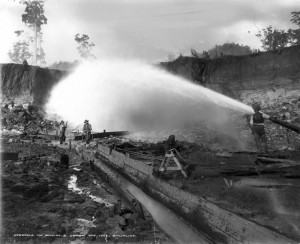
Hydraulic sluicing on the north-eastern Tasmanian tin fields. O’Rourke’s hydraulic gold mine operated in the same manner. Stephen Spurling III photo, courtesy of Stephen Hiller.

The Five Mile Rise goldfield, between the upper Forth River and the Middlesex Plains, north-western Tasmania, showing the position of the O’Rourke’s hydraulic gold mine.
Had Tasmanian miner Teddy O’Rourke been an interior decorator, he would have been a shoo-in for a colonial courtroom refit. His familiarity with magistrates’ chambers from Hobart to Deloraine, with dalliances at Kempton, Lefroy , George Town and almost a permanent booking in Launceston, must have been unsurpassed. Unfortunately, he was probably often too drunk to remember the decor. Yet Teddy also seems to have found a way to beat the bottle for two decades.
Edward Martin O’Rourke was born into an Irish Catholic family in Hobart in about 1856. A newspaper report of his mother Eliza (née O’Donnell or Donnell, a convict[1]) leaving home to escape violent attack by his father, ex-convict constable Martin O’Rourke (or Rourke), when he was an infant suggests that his was not a happy, comfortable childhood.[2] His education was probably rudimentary, as he remained illiterate.[3] By the time Martin O’Rourke drowned trying to ford the Forester River in 1876 at the age of 45, Teddy had at least five siblings.[4] It was after that that Teddy, along with his mother and sister Mary Ann Stratton, started making regular appearances in the Launceston Police Court, charged with assault (sometimes of each other), theft and drunk and disorderly behaviour.[5] The Jolly Butchers Hotel in Balfour Street kept by Eliza O’Rourke was the scene of some of this action.[6]
At the age of about 21 Teddy left Launceston for a rollicking lifestyle, racking up fines for public disturbances and learning how to handle a cradle at Brandy Creek, the alluvial goldfield that became Beaconsfield.[7] The only treatment he appears to have received for alcoholism was a stint in the slammer. One assault charge against him was dropped because his delirium tremens made him unable to testify.[8] Finally, in 1883, the judiciary lost patience and he got six months’ gaol for being idle and disorderly—followed by another three months for the same offence, this time in Hobart.[9] He served at least six terms in Hobart’s Campbell Street Gaol.[10]
Yet after 1892 O’Rourke stayed out of trouble for more than 20 years. Was mining his saviour? Men like Syd Reardon and Paddy Hartnett at Lorinna, 20 km from the nearest hotel, are said to have found an escape from the bottle in the bush. Perhaps Teddy’s experience on the Five Mile Rise when it was a diggers’ gold field in the 1880s was literally a sobering one.[11]
Then in about 1893 the New Zealand hydraulic craze hit Tasmania, and old gold fields like the Five Mile Rise got another trial, this time with the high-pressure hydraulic hose. Teddy O’Rourke took a claim on Sunday Creek, high up the Five Mile Rise, built a hut nearby and embarked on an unusual seasonal regime. Since it was only in the wet season that he could get sufficient water to operate the high-pressure hose, he combined hydraulic sluicing with hunting. April, May and June were the traditional hunting season. Prospectors and miners in the bush generally snared and shot animals for food anyway, but processing their skins for sale would have enabled O’Rourke to maximise (and perhaps sustain) his winters in the bush. A photo of what is probably O’Rourke’s hut taken by Fred Smithies shows that it was equipped with a skin drying chimney typical of those developed in the Cradle Mountain-Middlesex Plains area for the drying of possum and wallaby skins.
Teddy now revealed that not only could he make the press but he could use it. The secret to raising capital, apparently, was constant self-reference in the mining columns of newspapers. Harold Tuson grew up at Lorinna. In 1911, at the age of thirteen, he started work on gangs making tracks and roads in the upper Forth River region. During this time he came to know O’Rourke well as a fellow road worker, one of the latter’s summer jobs. He recalled the ‘big lump of a [Tasmanian-born] Irishman’ speaking with a thick Irish brogue. Having survived two or three bushfires, O’Rourke’s hut was then clearly visible from Lorinna high on the hill. Tuson recalled the miner’s struggle with alcoholism and his appearances in both the legal and mining columns of the newspaper: ‘“O’Rourke’s Hydraulic showing gold freely in the face”. That was one of Teddy’s. He’d write that to the paper to keep it going’.[12] Other stock phrases included ‘sluicing on payable gold’.
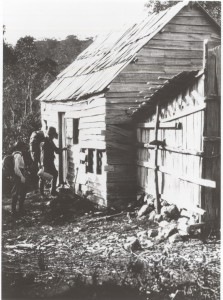
‘Hut at the top of the Forth Gorge track’, probably O’Rourke’s hut, showing the typical skin shed chimney favoured by Middlesex area hunters.
Fred Smithies photo, NS573/4/9/32 (TAHO)
O’Rourke’s hut stood near the beginning of the pack track down to the Devon mine in the Dove River Gorge. This pack track had become part of an extraordinarily steep route used by hunters to gain access to the Cradle Mountain region. On the southern side of the Dove River Gorge, the route continued up a steep hill known as Paddys Nut and crossed the Campbell River.[13] This was the route used by hunters Tom Jones and Bert Hansen in the winter of 1905 when the latter was tragically lost in a snowstorm near the lake near Cradle Mountain that now bears his name. Jones reported four-feet-deep snow as he began to make his way out to O’Rourke’s hut to raise the alarm, giving some idea of the conditions the gold miner experienced during these winter stints.[14] Since there are no mining reports to the press from O’Rourke in 1905, hunting may have been his primary activity during that wet season.
He also had business elsewhere. In 1904 O’Rourke had taken up a tungsten claim nearby, and by 1907 he was based at Ringarooma in the north-east, where he discovered the Montrose tin mine.[15] Later he turned his attention to the Colebrook tin field on the west coast, where he held a claim for a Launceston syndicate.[16] Meanwhile, in his absence, his hut on the Five Mile Rise was entered, robbed and forfeited to the Crown.[17] Thus the only property Ted O’Rourke ever owned was lost.
In 1911 he had a child, Edeline O’Rourke, with the recently widowed Annie Bissett (née Garrett) in Launceston.[18] She already had five children! Family responsibilities would have necessitated a steady income, hence, perhaps, O’Rourke’s work on the road gang. Eventually he may have got too old for bush life. Again, he was not at his best in town near the pubs. O’Rourke’s declining years contained a familiar litany of court appearances, including charges of disturbing the peace and vagrancy.[19] In 1919 the 63-year-old was found lying unconscious with a gashed head on a Launceston street.[20] In 1920 he was described as ‘an old habitue’ when defending a charge of being drunk and incapable in Albert Park on Christmas Day and in Charles Street a few days later.[21] He sported a scar over his left eye, perhaps as the result of some drunken escapade.[22] In 1922 he absconded when wanted for non-maintenance of his children, being tracked down in Deloraine.[23] In 1924, at 68 years of age, he was again found drunk and incapable in the street.[24] The trail of self-destruction stops there.
Like so many children of ex-convicts who could never escape the cycle of poverty and alcoholism into which they were born, Ted O’Rourke would have died intestate, with few possessions. His death stirred no comment in the press. Perhaps no one mourned his passing. However, I like to think of him as an innovator. He developed an unusual regime of hose, snare and, perhaps, teetotal, which kept him upright for two decades, drying out when the wet winter season brought his mining claim to life. That counts him as a success!
[1] Eliza O’Donnell was transported on the Midlothian. See permission to marry, 4 April 1855, CON52/1/7, p.408 (TAHO) and marriage certificate 473/1855, Hobart.
[2] ‘Local intelligence’, Colonial Times, 17 March 1857, p.3.
[3] Campbell Street Gaol Gate-book, warrant no.17591, 18 February 1889; records compiled by Laurie Moody; http://www.tasmanianwarcasualties.com/gravesofts%20split/Campbell%20Street%20Gaol/Rural%20Offences%20Part%209.htm
[4] See inquest, POL709/1/13, p.31 (TAHO); ‘Police Court’, Launceston Examiner, 20 January 1877, p.3. Martin Rourke was tried at Galway on 23 June 1848, sentenced to seven years, and came to Tasmania on the Lord Balhousie, being pardoned in 1855.
[5] See, for example, ‘Police Court’, Launceston Examiner, 21 September 1876, supplement p.2; ‘Police Court’, Launceston Examiner, 9 November 1876, p.4.
[6] ‘Quarterly licence meeting’, Launceston Examiner, 8 August 1876, p.3; ‘Police Court’, Launceston Examiner, 9 November 1876, p.4; ‘No true bill’, Launceston Examiner, 1 March 1877, p.2.
[7] ‘George Town’, Reports of Crime, 5 April 1878, pp.55–56.
[8] ‘Launceston Police Court’, Launceston Examiner, 26 April 1882, p.3.
[9] ‘Launceston Police Court’, Launceston Examiner, 12 November 1883, p.3; ‘City Police Court’, Mercury, 17 December 1884, p.2.
[10] Laurie Moody, ‘Campbell Street Gaol: inmates 1873–1890’, Tasmanian Ancestry, vol.26, no.2, September 2005, pp.24–30.
[11] Harold Tuson, interviewed in Canberra, 11 May 1995.
[12] Harold Tuson, interviewed in Canberra, 11 May 1995.
[13] See, for example, ‘North Western notes’, Mercury, 4 August 1905, p.2.
[14] ‘Cradle Mountain mystery’, North Western Advocate and the Emu Bay Times, 11 September 1905, p.2.
[15] ‘Iris River wolfram field’, Examiner, 20 September 1904, p.2; ‘Discovery of tin’, Examiner, 26 October 1906, p.2.
[16] See, for example, ‘Colebrook tin fields’, Examiner, 24 February 1912, p.4.
[17] POL386/1/1, Daily Record of Crime Occurrences – Sheffield 1901-1916 (TAHO).
[18] Birth registration 4877/1911, Launceston. See ‘Branxholm railway accident’, Mercury, 26 April 1910, p.2.
[19] ‘Police Courts, Hobart’, Mercury, 21 September 1915, p.6; ‘Police Court’, Launceston Examiner, 3 November 1916, p.4; ‘City Police Court’, Launceston Examiner, 13 April 1917, p.4; ‘City Police Court’, Daily Telegraph, 18 June 1918, p.4.
[20] ‘An old age pensioner’s plight’, Launceston Examiner, 26 December 1919, p.4.
[21] ‘City Police Court’, Daily Telegraph, 6 January 1920, p.2.
[22] ‘Prisoners to be discharged’, Police Gazette, 9 April 1920, p.69.
[23] ‘Persons enquired for’, Police Gazette, 23 June 1922, p.114; ‘Absconders’, Police Gazette, 14 July 1922, p.127.
[24] ‘City Police Court’, Daily Telegraph, 15 December 1924, p.4.



















